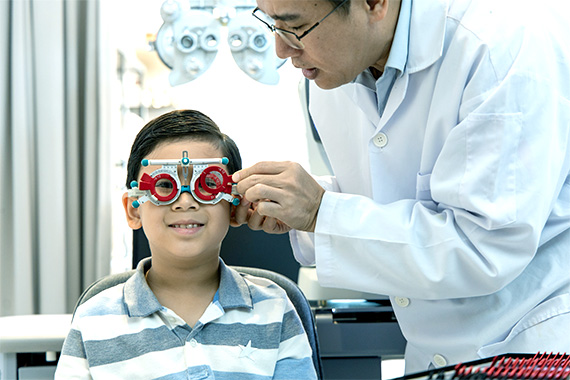Myopia, also known as nearsightedness, is a common refractive error where distant objects appear blurry while close objects can be seen clearly. This occurs when the eyeball is too long, or the cornea has too much curvature, causing light entering the eye to focus in front of the retina instead of directly on it. Myopia is a prevalent condition that affects people of all ages, often developing in childhood and progressing into early adulthood.

Book Appointment Download Brochure
The primary symptom of myopia is difficulty seeing distant objects clearly, which may include:
These symptoms can vary in severity depending on the degree of nearsightedness. Early detection and correction are crucial to prevent further vision impairment.
It's essential to consult an eye doctor if you experience any of the following:
Early diagnosis and treatment can prevent myopia from worsening and improve your quality of life.
Myopia is primarily caused by a mismatch between the length of the eyeball and the focusing power of the cornea and lens. This discrepancy leads to light focusing in front of the retina rather than directly on it. Several factors contribute to the development of myopia, including:
A family history of myopia significantly increases the risk of developing the condition.
Prolonged close-up activities, such as reading or using digital devices, can contribute to the onset of myopia.
Studies suggest that spending less time outdoors during childhood may increase the risk of developing myopia.
Myopia can be categorized into different types based on its severity and progression:
The most common form, usually mild to moderate, often stabilizes in early adulthood.
A more severe form where the refractive error is greater than -6.00 diopters, potentially leading to serious eye health complications.
A progressive form of high myopia that can cause structural changes in the eye, leading to conditions like retinal detachment or macular degeneration.
Several risk factors increase the likelihood of developing myopia, including:
Children with one or both parents with myopia are at higher risk.
Activities requiring intense focus on close objects, like reading or screen use, can strain the eyes and contribute to myopia development.
Insufficient exposure to natural light has been linked to a higher incidence of myopia in children.
While myopia cannot always be prevented, certain strategies may help reduce the risk or slow its progression:
Routine eye check-ups can detect myopia early and allow for timely intervention.
Encourage a mix of near work and outdoor activities to reduce eye strain.
Ensure adequate lighting while reading or working to minimize eye strain.
Wearing prescribed glasses or contact lenses can correct vision and reduce the progression of myopia.
Specially designed contact lenses worn overnight can temporarily reshape the cornea, reducing the need for glasses during the day.
Myopia, or nearsightedness, is a common vision condition that can significantly impact daily life if left unaddressed. Understanding the symptoms, causes, and risk factors is essential for managing and potentially preventing its progression. Regular eye exams and adopting healthy visual habits can help maintain clear vision and reduce the long-term impact of myopia. If you suspect you or your child may be developing myopia, schedule an appointment with an eye doctor for a comprehensive evaluation.
While Shree Ramkrishna Netralaya is your top choice for eye care in Mumbai, you may also consider our other reputable clinics and hospitals near you.
Address:
201 & 202 Elmer #Plot #563, Central Avenue, Corner of, 11th Rd, Chembur, 400071
Phone: 082917 14838
Timing: Mon-Sat- 10 a.m. To 8 p.m.
Address:
Near Risk Care Hospital, Near Makhamali Talao, LBS Marg, Thane, W, Mumbai, Maharashtra 400601
Phone: 02225441139
Timing: Mon-Sat- 11 a.m. To 8 p.m.